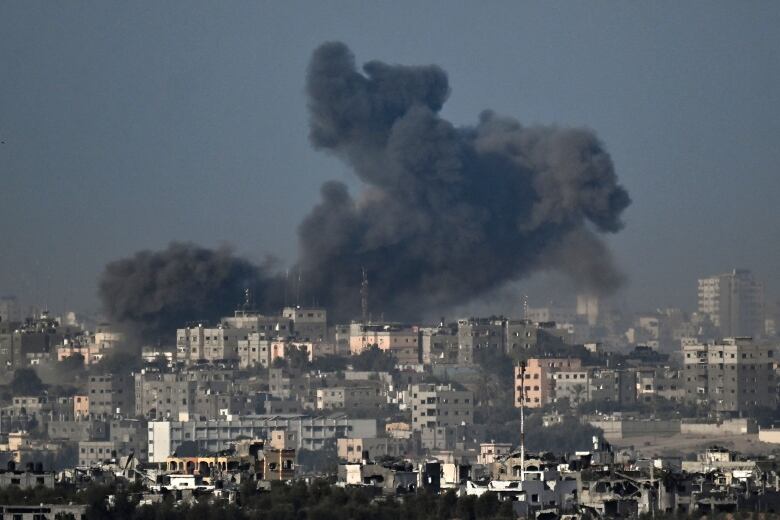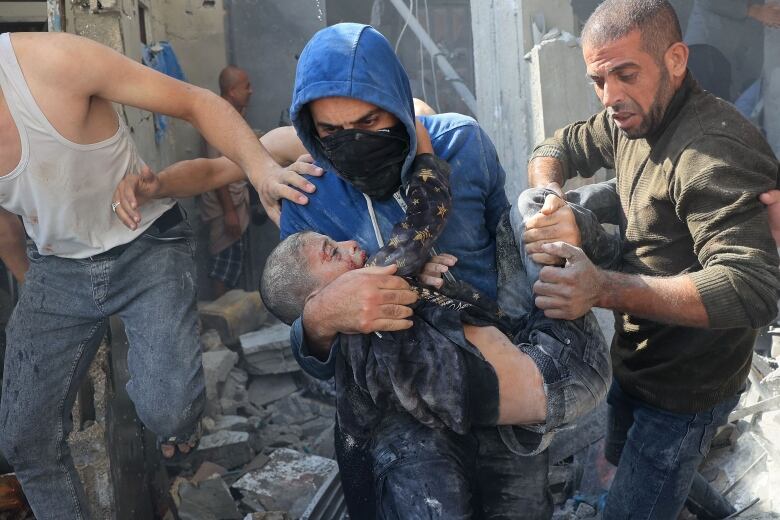Israel says Hamas leader trapped in bunker as its troops battle militant group in Gaza City
'Gaza City is encircled, we are operating inside it,' says Israeli prime minister
The latest:
- 75 Canadians, permanent residents and family members have now left Gaza.
- Netanyahu says Israel seeking 'indefinite period' of control over Gaza security.
- Palestinian health officials say Israeli strikeskill at least 23 in south Gaza.
Israel said on Tuesday that its forces were operating deep in Gaza City in their battle to wipe out Hamas in the Palestinian enclave and that the Islamist militant group's leader was trapped inside a bunker.
Gaza residents said earlier that Israeli tanks were positioned on the outskirts of Gaza City, Hamas's stronghold in the north of the territory and home to about one-third of its 2.3 million people before the hostilities.
Israel previously said it had surrounded Gaza City and would soon attack it to annihilate Hamas fighters who assaulted Israeli towns across the border one month ago.
Defence Minister Yoav Gallant said Israeli soldiers were operating in the heart of Gaza City. Hamas's most senior leader in Gaza, Yahya Sinwar, was isolated in his bunker, Gallant said in a televised news conference.

Israel Defence Forces (IDF) "came from the north and the south. They stormed it in full co-ordination between land, air and sea forces," Gallant said.
"They are manoeuvring on foot, armoured vehicles and tanks, along with military engineers from all directions, and they have one target: Hamas terrorists in Gaza, their infrastructure, their commanders, bunkers, communication rooms. They are tightening the noose around Gaza City."
- Are you in the Middle East and affected by the war between Israel and Hamas? We want to hear about your experience. Send an email to ask@cbc.ca.
He said that below the city there were kilometresof tunnels that ran under schools and hospitals and that housed weapons depots, communication rooms and hideouts for militants.
"Gaza City is encircled, we are operating inside it," Israeli Prime Minister Benjamin Netanyahu said in a televised statement. "We are increasing pressure on Hamas every hour, every day. So far, we have killed thousands of terrorists, above ground and below ground."
The Israeli military said Hamas militants fired anti-tank missiles at Israeli forces from nearby hospitals and that soldiers found weapons hidden in a school in northern Gaza.
The military wing of Hamas, which has ruled the small, densely populated enclave for 16 years, said its fighters were inflicting heavy losses and damage on advancing Israeli forces. It had no immediate comment on the possible fate of Sinwar, the Hamas leader.
It was not possible to verify the battlefield claims of either side.
'Incessant suffering'
The war the bloodiest episode in the generations-old Israeli-Palestinian conflict broke out on Oct. 7 when Hamas fighters burst across the fence enclosing Gaza and killed 1,400 Israelis, including several Canadians, and abducted more than 200, according to Israeli tallies.
Since then, Israel has bombarded the coastal territory relentlessly, killing more than 10,000 people, about40 per cent of them children, according to counts by Gaza health officials.
"It has been one full month of carnage, of incessant suffering, bloodshed, destruction, outrage and despair," United NationsHuman Rights Commissioner Volker Turk said in a statement at the start of a trip to the region.
Israel, which is trying to clear out Gaza City, gave residents a window from 10 a.m. to 2 p.m. local time to leave for the southern part of the 45-kilometrelong Gaza Strip.
Residents say Israeli tanks have been moving mostly at night, with Israeli forces largely relying on air and artillery strikes to clear a path for their ground advance.
Gaza's Interior Ministry says 900,000 Palestinians are still sheltering in northern Gaza, including Gaza City.

"The most dangerous trip in my life. We saw the tanks from point blank [range]. We saw decomposed body parts. We saw death," resident Adam Fayez Zeyara posted with a selfie of himself on the road out of Gaza City.
Gallant, Israel's defence minister, repeated the calls for civilians to move south for their own safety. He also said that after the war was finished, neither Israel nor Hamas would rule Gaza.
Airstrikes, evacuations in south Gaza
While Israel's military operation is focused on the northern half of Gaza, the south has also come under attack. Palestinian health officials said at least 23 people were killed in two separate Israeli airstrikes early on Tuesday in the southern Gaza cities of Khan Younis and Rafah.
"We are civilians," said Ahmed Ayesh, who was rescued from the rubble of a house in Khan Younis, where health officials said 11 people had been killed. "This is the bravery of the so-called Israel, they show their might and power against civilians, babies inside, kids insideand elderly."
As he spoke, rescuers at the house used their hands to try to free a girl buried up to her waist in debris.

Meanwhile, also in south Gaza, the first cohort of Canadian citizens and family members eligible to leave Gaza gathered at the Rafah border crossing with Egypt on Tuesday morning after receiving a notice from Global Affairs Canada (GAC).
The agency confirmed that 75 Canadians, permanent residents and family members have crossed into Egypt.
Among them was a family from Calgary. Mansour Shouman, a Canadian citizen since 2006, told CBC News that his wife and five children crossed on Tuesday at about9 a.m.but that he chose to stay to help those still in Gaza.
Israel wants 'security responsibility' over Gaza
Both Israel and Hamas have rebuffed mounting calls for a halt in fighting. Israel says hostages should be released first, but Hamas says it will not free them nor stop fighting while Gaza is under attack.Washington has backed Israel's position that a ceasefire would help Hamas militarily.
Israel has so far been vague about its long-term plans for Gaza, should it succeed in its operation to vanquish Hamas. In some of the first direct comments on the subject, Netanyahu said Israel would seek to have security responsibility for Gaza "for an indefinite period."
"We've seen what happens when we don't have that security responsibility," he told U.S. television's ABC News.
Israel pulled its troops and settlers from the Gaza Strip in 2005, and two years later, Hamas took power there driving out the Palestinian Authority, which exercises limited self-rule in a separate, Israeli-occupied territory, the West Bank.
White House spokesperson John Kirby said U.S. President Joe Biden opposed Israeli reoccupation: "It's not good for Israel, it's not good for the Israeli people," Kirby told CNN.
U.S. Secretary of State Antony Blinken had spoken with leaders in the region about what governance of Gaza could look like after the war, Kirby said: "Whatever it is, it can't be what it was on Oct. 6. It can't be Hamas."
Diplomatic discussions about how Gaza could be ruled after the war have considered the deployment of a multinational force, an interim Palestinian-led administration excluding Hamas, a stopgap security and governance role for neighbouring Arab states, and temporary UNsupervision of the enclave, according to a source familiar with the matter.
With files from CBC News
















_(720p).jpg)


 OFFICIAL HD MUSIC VIDEO.jpg)
.jpg)



























































































